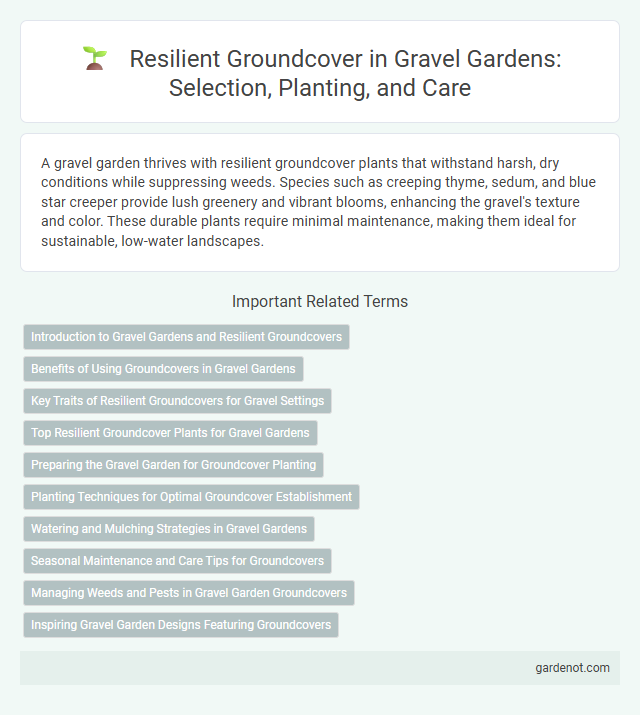A gravel garden thrives with resilient groundcover plants that withstand harsh, dry conditions while suppressing weeds. Species such as creeping thyme, sedum, and blue star creeper provide lush greenery and vibrant blooms, enhancing the gravel's texture and color. These durable plants require minimal maintenance, making them ideal for sustainable, low-water landscapes.
Introduction to Gravel Gardens and Resilient Groundcovers
Gravel gardens combine decorative stones with hardy, drought-tolerant groundcovers to create sustainable, low-maintenance landscapes. Resilient groundcovers such as sedum, creeping thyme, and blue star creeper thrive in gravel beds by retaining moisture and preventing soil erosion. These plants adapt well to poor soil conditions and excessive heat, making them ideal for eco-friendly and water-wise gardening solutions.
Benefits of Using Groundcovers in Gravel Gardens
Resilient groundcovers in gravel gardens minimize soil erosion, improve moisture retention, and suppress weed growth, creating a low-maintenance landscape. These plants enhance aesthetics by adding texture and color contrast against the gravel, promoting biodiversity and habitat for beneficial insects. Utilizing drought-tolerant species further conserves water and adapts well to the porous, well-drained conditions of gravel gardens.
Key Traits of Resilient Groundcovers for Gravel Settings
Resilient groundcovers for gravel gardens exhibit drought tolerance, low maintenance needs, and robust root systems that stabilize gravel and prevent erosion. Key traits include the ability to thrive in poor, well-drained soils and withstand foot traffic without damage. These plants often feature deep roots, rapid spreading growth habits, and high resistance to pests and diseases.
Top Resilient Groundcover Plants for Gravel Gardens
Top resilient groundcover plants for gravel gardens include creeping thyme, sedum, and creeping phlox, known for their drought tolerance and low maintenance. These species thrive in well-drained, nutrient-poor soils typical of gravel gardens, providing vibrant colors and textures while preventing soil erosion. Their deep root systems enhance ground stability and support biodiversity by attracting pollinators such as bees and butterflies.
Preparing the Gravel Garden for Groundcover Planting
Preparing a gravel garden for resilient groundcover planting involves thorough soil assessment and amendment to ensure adequate drainage and nutrient availability. Incorporating a weed barrier fabric reduces competition and supports healthy root establishment. Selecting drought-tolerant, low-maintenance species maximizes survival and visual appeal in challenging gravel garden conditions.
Planting Techniques for Optimal Groundcover Establishment
Selecting drought-tolerant, low-maintenance plants like creeping thyme or sedum ensures resilience in gravel garden groundcovers. Planting during the early spring or fall maximizes root establishment by leveraging moderate soil moisture and temperature conditions. Incorporating a thin layer of organic mulch around the base of seedlings conserves moisture and suppresses weed competition, promoting robust groundcover development.
Watering and Mulching Strategies in Gravel Gardens
Resilient groundcovers in gravel gardens thrive with careful watering practices that emphasize deep, infrequent irrigation to encourage strong root development and drought tolerance. Mulching with inorganic materials like gravel or crushed stone helps retain soil moisture, regulate temperature, and suppress weed growth, essential for maintaining healthy groundcovers. These strategies optimize water efficiency and promote sustainable growth in the challenging conditions of gravel garden environments.
Seasonal Maintenance and Care Tips for Groundcovers
Choose resilient groundcovers like sedum or creeping thyme to thrive in gravel gardens with minimal upkeep. Regular seasonal maintenance includes removing weeds during spring, pruning dead foliage in late autumn, and monitoring soil moisture to prevent drought stress. Applying a thin layer of mulch in early winter helps retain moisture and protect roots from harsh temperature fluctuations.
Managing Weeds and Pests in Gravel Garden Groundcovers
Selecting resilient groundcovers such as creeping thyme and sedum effectively suppresses weeds by creating dense mats that block sunlight from weed seeds. Regular monitoring and early pest control through natural predators like ladybugs or organic insecticidal soaps prevent infestations without harming plant health. Maintaining proper gravel depth and good air circulation further reduces weed growth and pest habitat in gravel garden groundcovers.
Inspiring Gravel Garden Designs Featuring Groundcovers
Resilient groundcovers such as creeping thyme, sedum, and moss phlox thrive in gravel gardens by suppressing weeds and retaining soil moisture. These drought-tolerant plants enhance texture and color contrast against gravel, creating visually striking and low-maintenance landscapes. Incorporating native species like creeping juniper or blue star creeper ensures year-round resilience and adaptability to varying gravel garden conditions.
Resilient groundcover Infographic

 gardenot.com
gardenot.com